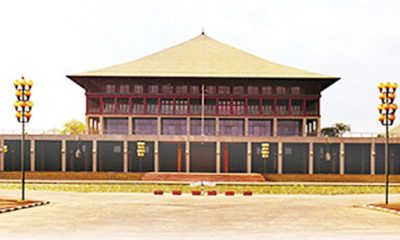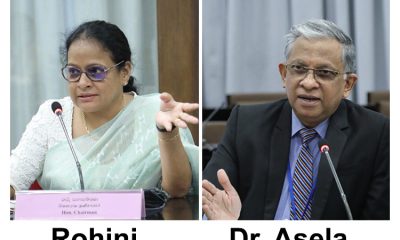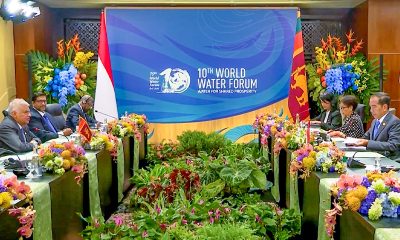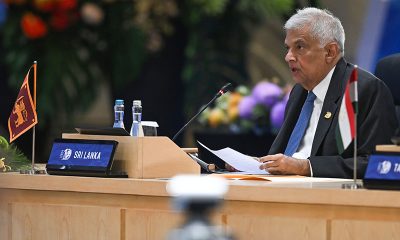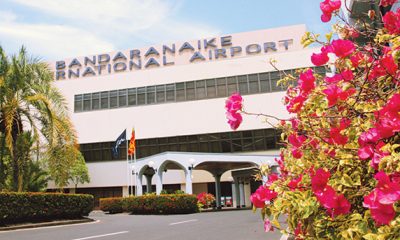Features
Middle East Imbroglio: Two Wars Fifty Years Apart
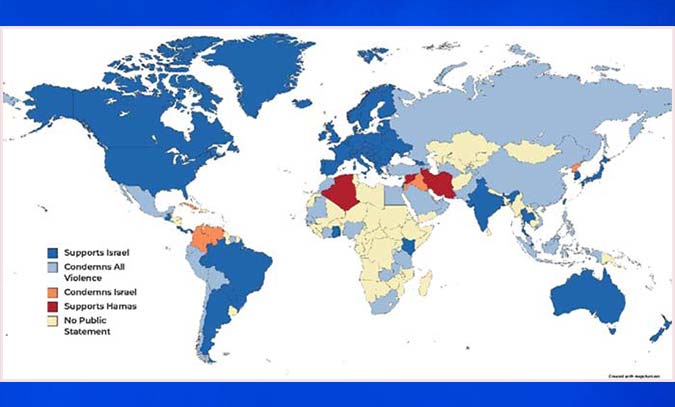
by Rajan Philips
Shlomo Ben-Ami, Israeli academic, Oxford historian, and Foreign Minister of Israel in Ehud Barak’s government, has provided one of the more even handed assessments of the current situation in Israel. In an opinion piece, published in Canada’s Globe and Mail, and entitled, “The destructive hubris of Benjamin Netanyahu,” Dr. Ben-Ami writes that “Mr. Netanyahu’s hubris met its nemesis in the form of Hamas’s brutality.” One cannot separate Mr. Netanyahu’s self-serving intransigence towards the Palestinians throughout his time in office as Prime Minister, from the biggest attack on Israel in 50 years that was launched by Hamas last Saturday, October 7. It was a day after the 50th anniversary of the 1973 war against Isarel that was started with some surprise by Egypt and Syria.
There are comparisons being made between the two clashes 50 years apart. Comparisons range from historical symbolism to contextual differences to geopolitical fallouts. John Rapley, Political Economist, Cambridge, has noted that while the 1973 war transformed the global economy by creating the petroleum crisis, the current war is unlikely to have similarly far reaching impacts. The embargo on oil shipment (from the Middle East to the US), imposed by the Arab countries in retaliation to US support of Israel, argues Prof. Rapley, set off a series of events that changed the world economic order.
While the end of the Bretton Wood system of fixed exchange rates had already begun, the petroleum crisis accelerated the end of postwar prosperity in the west, triggered the new phenomenon of stagflation, and led to the start of the war on inflation by Central Banks. The world economy is now different, far more widespread and diverse, and far less dependent on oil.
The current skirmish will have its economic fallout with oil price increases but nowhere near the crisis of the 1970s, unless the situation escalates into a full-scale conflict between Israel and Iran. While Iran is widely suspected in the west to be the hidden hand behind Hamas’s incursion into Israel, there is also general acknowledgment that there is no evidence of Iran’s involvement. And the US that has already declared its solidarity with Israel and is escalating its aircraft carrier presence in the region while sending ammunition to Israel, will also likely be a deterrent against any regional escalation of the crisis.
Aftermaths of 1973
The west’s declining dependence on Middle Eastern oil may also have been a factor in the Palestinian problem becoming a lesser concern in the foreign policy considerations of the west in general, and particularly in the US. But there have been other and more significant developments that have pushed the Palestinian question to the back-burner. The experience of the 1973 war led to Israel and Arab countries working towards bilateral rapprochements and the pursuit of a parallel peace process between Israel and the Palestinians. The linkage between Palestinian liberation and Arab leadership was beginning to get attenuated, if not totally severed.
The 1978/79 Camp David Accords between Egypt and Israel, although controversial and divisive, significantly changed the course of Middle Eastern politics. The Oslo Peace Accords of 1993 and 1995 between Israel and the Palestinians were another landmark achievement even though they were frustrated from reaching the elusive final settlement. Even the gains of the Peace Accords, the establishment of the Palestinian National Authority and limited Palestinian self-government in the West Bank and the Gaza Strip were frustrated from reaching their full potentials.
There was also opposition to the Oslo Accords among both the Palestinians and the Israelis. The redoubtable Ishrak Rabin, the Israeli Prime Minister who signed the Oslo Accords with PLO’s Yasser Arafat, paid with his life for pursuing peace, gunned down by a right-wing lunatic. From a Palestinian standpoint, the great Edward Said pungently described the Oslo Accords as “Palestinian Versailles.”
The disagreements over the Peace Accords gave the new Palestinian militants, especially Hamas, considerable advantage over the old Palestinian Liberation Organization (PLO), which came to be identified as a corrupt and upstart establishment. On the Israeli side, the right-wing forces were on the ascent and during Benjamin Netanyahu’s long spell as Prime Minister, even the paltry Oslo gains were not only stymied, but also reversed.
The unfolding tragedy was given a farcical fillip when Donald Trump became US President while Netanyahu was at the height of his powers as Israeli Prime Minister. Between them, they ignored the Palestinians, symbolically and substantively, and set about cultivating bilateral agreements between Arab countries and Israel for ultimately profiting business interests.
The famous or infamous Abraham Accords, usually credited to Donald Trump and his son-in-law Jarred Kushner, became the new framework for Arab-Israeli normalization while excluding the Palestinians. In September 2020, two months before Trump’s defeat by Joe Biden in the US presidential elections, the United Arab Emirates and Bahrain became the first Arab countries to formally recognize Israel’s sovereignty and open diplomatic relations with the Jewish state. Morocco and Sudan followed while Trump was still in office after the defeat and was busy plotting the January 6 uprising.
Warnings Ignored
The new Biden Administration continued the initiative, but chose to jettison the title “Abraham Accords” and use “normalization agreements” instead. The State Department also made it clear that Arab-Israeli normalization is “not a substitute for Israeli-Palestinian peace,” and expressed the hope that the new normalization agreements will “contribute to tangible progress towards the goal of advancing a negotiated peace between Israelis and Palestinians.” But all hopes were dashed when Netanyahu returned as Prime Minister in December 2022 (after being out of office from June 2021) and cobbled together the most right-wing and incompetent government in Israel’s history.
Netanyahu’s return to power has been possible only because of the concessions he made to right-wing fringe parties, and satisfying his new coalition partners has come at the heavy price of alienating the Palestinians and aggravating their conditions in the West Bank and in Gaza. In addition to allowing Jewish takeover of Palestinian lands and the spread of illegal Jewish settlements, the Netanyahu government also provoked the Palestinians by infringing sacred Muslim areas within Jerusalem.
All the while, Mr. Netanyahu was trying to expand the Abraham Accords with far flung countries like Indonesia, Niger, Mauritania, and Somalia, in addition to finalizing the more prized normalization with Saudi Arabia next door. And he kept ignoring warnings from the Americans and Saudis, even when they came jointly from Secretary of State Anthony Blinken and Saudi Foreign Minister Prince Faisal bin Farham.
In June of this year, the US Secretary of State travelled to Saudi Arabia for bilateral discussions on what a New York Times report called a “smorgasbord of issues: Iran, Sudan, the Islamic State, regional infrastructure, clean energy and the potential normalization of Saudi-Israel relations.” The larger purpose, of course, was to stem Saudi Arabia from tilting too much towards China and Russia.
Later in June, Mr. Blinken and Prince Farham participated at a Council on Foreign Relations event in New York. As reported by CNN, both men stressed that the expansion of Arab Israeli normalization will not be possible in a climate of rising Israeli-Palestinian tensions. Mr. Blinken said that he had raised this issue in conversations with Prime Minister Netanyahu and his Foreign Minister Eli Cohen. For his part, the Saudi Foreign Minister added that while normalization would in the broader interest of the region, the benefits would be limited if the challenge of “finding a pathway to peace for the Palestinian people” were not addressed at the same time.
Whether these warnings were not strong enough, or whether the Netanyahu government would not have heeded them anyway, no one foresaw that they would come true so quickly and with such ferocity. The Netanyahu government is already under fire for the massive intelligence failure that left the government and the military totally clueless about what Hamas must have been planning for quite some time and what it would all of a sudden unleash.
The circumstances of Netanyahu’s return to power and his efforts to muzzle the judiciary have divided the country through the middle, and the attack on Israel by Hamas may have unified the country behind its now beleaguered Prime Minister. The government has formally declared war on Hamas, and has promised to take “significant military steps” to destroy the “military and governing capabilities” of Hamas, which according to Mr. Netanyahu will prevent Hamas from “threatening Israelis for many years.”
The punishment of Hamas will continue until there is nothing left to punish, or the punishment extends too long and leads to too much suffering to test the sensibilities of proportionality. Whether Hamas deserves the punishment it is getting is a moot question because deserving has nothing to do with this. It was going to get punished anyway, and Hamas would have had no illusions about escaping punishment when it embarked on its biggest and most horrific incursion in its 45 year history.
Prime Minister Netanyahu and his government will have their own problems. Their governing mandate will now be limited to punishing Hamas. Beyond that, they will be under intense scrutiny for any and all of their actions. That in itself could be an opening for a new phase in the tortuous history of Israeli-Palestinian relations.
World Reactions
According to an analysis of “International Reactions to the Hamas Attack on Israel,” undertaken by researchers at The Washington Institute for Near East Policy (see map on this page), about 100 countries have reacted to the unfolding situation in Israel and in Gaza. Forty four countries are said to have condemned Hamas, while most of the Arab countries have blamed Israel for the attacks. Most of Africa has not expressed a public position, while China and a number of ASEAN countries in Asia, Turkey and Saudi Arabia in the Middle East, Russia in Eastern Europe, South Africa, and Mexico and Chile in the Americas, are condemning all violence.
India has joined the ranks of the west supporting Israel, along with Brazil and Argentina, exposing new cleavages among the BRICS countries. Of the original BRICS members, Brazil and India are supporting Israel, while Russia, China and South Africa are grouped against all violence. As the Washington Institute’s map shows, world reactions are literally all over the map, and there is no single group of countries that can claim to speak for the ‘world,’ let alone act on behalf of the world.
The west’s rhetoric of speaking for the world is practically limited to NATO countries, which are now more than occasionally joined by India as part of its ‘all-aligned’ approach to international affairs. The expression of solidarity with Israel is meaningless in practical terms because there is no country threatening war against Israel, and there is no country that can stop Israel from pulverizing Gaza (40 km by 10 km land-strip habitat for two million Palestinians) for the sake of punishing Hamas.
Features
The heart-friendly health minister

by Dr Gotabhya Ranasinghe
Senior Consultant Cardiologist
National Hospital Sri Lanka
When we sought a meeting with Hon Dr. Ramesh Pathirana, Minister of Health, he graciously cleared his busy schedule to accommodate us. Renowned for his attentive listening and deep understanding, Minister Pathirana is dedicated to advancing the health sector. His openness and transparency exemplify the qualities of an exemplary politician and minister.
Dr. Palitha Mahipala, the current Health Secretary, demonstrates both commendable enthusiasm and unwavering support. This combination of attributes makes him a highly compatible colleague for the esteemed Minister of Health.
Our discussion centered on a project that has been in the works for the past 30 years, one that no other minister had managed to advance.
Minister Pathirana, however, recognized the project’s significance and its potential to revolutionize care for heart patients.
The project involves the construction of a state-of-the-art facility at the premises of the National Hospital Colombo. The project’s location within the premises of the National Hospital underscores its importance and relevance to the healthcare infrastructure of the nation.
This facility will include a cardiology building and a tertiary care center, equipped with the latest technology to handle and treat all types of heart-related conditions and surgeries.
Securing funding was a major milestone for this initiative. Minister Pathirana successfully obtained approval for a $40 billion loan from the Asian Development Bank. With the funding in place, the foundation stone is scheduled to be laid in September this year, and construction will begin in January 2025.
This project guarantees a consistent and uninterrupted supply of stents and related medications for heart patients. As a result, patients will have timely access to essential medical supplies during their treatment and recovery. By securing these critical resources, the project aims to enhance patient outcomes, minimize treatment delays, and maintain the highest standards of cardiac care.
Upon its fruition, this monumental building will serve as a beacon of hope and healing, symbolizing the unwavering dedication to improving patient outcomes and fostering a healthier society.We anticipate a future marked by significant progress and positive outcomes in Sri Lanka’s cardiovascular treatment landscape within the foreseeable timeframe.
Features
A LOVING TRIBUTE TO JESUIT FR. ALOYSIUS PIERIS ON HIS 90th BIRTHDAY

by Fr. Emmanuel Fernando, OMI
Jesuit Fr. Aloysius Pieris (affectionately called Fr. Aloy) celebrated his 90th birthday on April 9, 2024 and I, as the editor of our Oblate Journal, THE MISSIONARY OBLATE had gone to press by that time. Immediately I decided to publish an article, appreciating the untiring selfless services he continues to offer for inter-Faith dialogue, the renewal of the Catholic Church, his concern for the poor and the suffering Sri Lankan masses and to me, the present writer.
It was in 1988, when I was appointed Director of the Oblate Scholastics at Ampitiya by the then Oblate Provincial Fr. Anselm Silva, that I came to know Fr. Aloy more closely. Knowing well his expertise in matters spiritual, theological, Indological and pastoral, and with the collaborative spirit of my companion-formators, our Oblate Scholastics were sent to Tulana, the Research and Encounter Centre, Kelaniya, of which he is the Founder-Director, for ‘exposure-programmes’ on matters spiritual, biblical, theological and pastoral. Some of these dimensions according to my view and that of my companion-formators, were not available at the National Seminary, Ampitiya.
Ever since that time, our Oblate formators/ accompaniers at the Oblate Scholasticate, Ampitiya , have continued to send our Oblate Scholastics to Tulana Centre for deepening their insights and convictions regarding matters needed to serve the people in today’s context. Fr. Aloy also had tried very enthusiastically with the Oblate team headed by Frs. Oswald Firth and Clement Waidyasekara to begin a Theologate, directed by the Religious Congregations in Sri Lanka, for the contextual formation/ accompaniment of their members. It should very well be a desired goal of the Leaders / Provincials of the Religious Congregations.
Besides being a formator/accompanier at the Oblate Scholasticate, I was entrusted also with the task of editing and publishing our Oblate journal, ‘The Missionary Oblate’. To maintain the quality of the journal I continue to depend on Fr. Aloy for his thought-provoking and stimulating articles on Biblical Spirituality, Biblical Theology and Ecclesiology. I am very grateful to him for his generous assistance. Of late, his writings on renewal of the Church, initiated by Pope St. John XX111 and continued by Pope Francis through the Synodal path, published in our Oblate journal, enable our readers to focus their attention also on the needed renewal in the Catholic Church in Sri Lanka. Fr. Aloy appreciated very much the Synodal path adopted by the Jesuit Pope Francis for the renewal of the Church, rooted very much on prayerful discernment. In my Religious and presbyteral life, Fr.Aloy continues to be my spiritual animator / guide and ongoing formator / acccompanier.
Fr. Aloysius Pieris, BA Hons (Lond), LPh (SHC, India), STL (PFT, Naples), PhD (SLU/VC), ThD (Tilburg), D.Ltt (KU), has been one of the eminent Asian theologians well recognized internationally and one who has lectured and held visiting chairs in many universities both in the West and in the East. Many members of Religious Congregations from Asian countries have benefited from his lectures and guidance in the East Asian Pastoral Institute (EAPI) in Manila, Philippines. He had been a Theologian consulted by the Federation of Asian Bishops’ Conferences for many years. During his professorship at the Gregorian University in Rome, he was called to be a member of a special group of advisers on other religions consulted by Pope Paul VI.
Fr. Aloy is the author of more than 30 books and well over 500 Research Papers. Some of his books and articles have been translated and published in several countries. Among those books, one can find the following: 1) The Genesis of an Asian Theology of Liberation (An Autobiographical Excursus on the Art of Theologising in Asia, 2) An Asian Theology of Liberation, 3) Providential Timeliness of Vatican 11 (a long-overdue halt to a scandalous millennium, 4) Give Vatican 11 a chance, 5) Leadership in the Church, 6) Relishing our faith in working for justice (Themes for study and discussion), 7) A Message meant mainly, not exclusively for Jesuits (Background information necessary for helping Francis renew the Church), 8) Lent in Lanka (Reflections and Resolutions, 9) Love meets wisdom (A Christian Experience of Buddhism, 10) Fire and Water 11) God’s Reign for God’s poor, 12) Our Unhiddden Agenda (How we Jesuits work, pray and form our men). He is also the Editor of two journals, Vagdevi, Journal of Religious Reflection and Dialogue, New Series.
Fr. Aloy has a BA in Pali and Sanskrit from the University of London and a Ph.D in Buddhist Philosophy from the University of Sri Lankan, Vidyodaya Campus. On Nov. 23, 2019, he was awarded the prestigious honorary Doctorate of Literature (D.Litt) by the Chancellor of the University of Kelaniya, the Most Venerable Welamitiyawe Dharmakirthi Sri Kusala Dhamma Thera.
Fr. Aloy continues to be a promoter of Gospel values and virtues. Justice as a constitutive dimension of love and social concern for the downtrodden masses are very much noted in his life and work. He had very much appreciated the commitment of the late Fr. Joseph (Joe) Fernando, the National Director of the Social and Economic Centre (SEDEC) for the poor.
In Sri Lanka, a few religious Congregations – the Good Shepherd Sisters, the Christian Brothers, the Marist Brothers and the Oblates – have invited him to animate their members especially during their Provincial Congresses, Chapters and International Conferences. The mainline Christian Churches also have sought his advice and followed his seminars. I, for one, regret very much, that the Sri Lankan authorities of the Catholic Church –today’s Hierarchy—- have not sought Fr.
Aloy’s expertise for the renewal of the Catholic Church in Sri Lanka and thus have not benefited from the immense store of wisdom and insight that he can offer to our local Church while the Sri Lankan bishops who governed the Catholic church in the immediate aftermath of the Second Vatican Council (Edmund Fernando OMI, Anthony de Saram, Leo Nanayakkara OSB, Frank Marcus Fernando, Paul Perera,) visited him and consulted him on many matters. Among the Tamil Bishops, Bishop Rayappu Joseph was keeping close contact with him and Bishop J. Deogupillai hosted him and his team visiting him after the horrible Black July massacre of Tamils.
Features
A fairy tale, success or debacle

Sri Lanka-Singapore Free Trade Agreement
By Gomi Senadhira
senadhiragomi@gmail.com
“You might tell fairy tales, but the progress of a country cannot be achieved through such narratives. A country cannot be developed by making false promises. The country moved backward because of the electoral promises made by political parties throughout time. We have witnessed that the ultimate result of this is the country becoming bankrupt. Unfortunately, many segments of the population have not come to realize this yet.” – President Ranil Wickremesinghe, 2024 Budget speech
Any Sri Lankan would agree with the above words of President Wickremesinghe on the false promises our politicians and officials make and the fairy tales they narrate which bankrupted this country. So, to understand this, let’s look at one such fairy tale with lots of false promises; Ranil Wickremesinghe’s greatest achievement in the area of international trade and investment promotion during the Yahapalana period, Sri Lanka-Singapore Free Trade Agreement (SLSFTA).
It is appropriate and timely to do it now as Finance Minister Wickremesinghe has just presented to parliament a bill on the National Policy on Economic Transformation which includes the establishment of an Office for International Trade and the Sri Lanka Institute of Economics and International Trade.
Was SLSFTA a “Cleverly negotiated Free Trade Agreement” as stated by the (former) Minister of Development Strategies and International Trade Malik Samarawickrama during the Parliamentary Debate on the SLSFTA in July 2018, or a colossal blunder covered up with lies, false promises, and fairy tales? After SLSFTA was signed there were a number of fairy tales published on this agreement by the Ministry of Development Strategies and International, Institute of Policy Studies, and others.
However, for this article, I would like to limit my comments to the speech by Minister Samarawickrama during the Parliamentary Debate, and the two most important areas in the agreement which were covered up with lies, fairy tales, and false promises, namely: revenue loss for Sri Lanka and Investment from Singapore. On the other important area, “Waste products dumping” I do not want to comment here as I have written extensively on the issue.
1. The revenue loss
During the Parliamentary Debate in July 2018, Minister Samarawickrama stated “…. let me reiterate that this FTA with Singapore has been very cleverly negotiated by us…. The liberalisation programme under this FTA has been carefully designed to have the least impact on domestic industry and revenue collection. We have included all revenue sensitive items in the negative list of items which will not be subject to removal of tariff. Therefore, 97.8% revenue from Customs duty is protected. Our tariff liberalisation will take place over a period of 12-15 years! In fact, the revenue earned through tariffs on goods imported from Singapore last year was Rs. 35 billion.
The revenue loss for over the next 15 years due to the FTA is only Rs. 733 million– which when annualised, on average, is just Rs. 51 million. That is just 0.14% per year! So anyone who claims the Singapore FTA causes revenue loss to the Government cannot do basic arithmetic! Mr. Speaker, in conclusion, I call on my fellow members of this House – don’t mislead the public with baseless criticism that is not grounded in facts. Don’t look at petty politics and use these issues for your own political survival.”
I was surprised to read the minister’s speech because an article published in January 2018 in “The Straits Times“, based on information released by the Singaporean Negotiators stated, “…. With the FTA, tariff savings for Singapore exports are estimated to hit $10 million annually“.
As the annual tariff savings (that is the revenue loss for Sri Lanka) calculated by the Singaporean Negotiators, Singaporean $ 10 million (Sri Lankan rupees 1,200 million in 2018) was way above the rupees’ 733 million revenue loss for 15 years estimated by the Sri Lankan negotiators, it was clear to any observer that one of the parties to the agreement had not done the basic arithmetic!
Six years later, according to a report published by “The Morning” newspaper, speaking at the Committee on Public Finance (COPF) on 7th May 2024, Mr Samarawickrama’s chief trade negotiator K.J. Weerasinghehad had admitted “…. that forecasted revenue loss for the Government of Sri Lanka through the Singapore FTA is Rs. 450 million in 2023 and Rs. 1.3 billion in 2024.”
If these numbers are correct, as tariff liberalisation under the SLSFTA has just started, we will pass Rs 2 billion very soon. Then, the question is how Sri Lanka’s trade negotiators made such a colossal blunder. Didn’t they do their basic arithmetic? If they didn’t know how to do basic arithmetic they should have at least done their basic readings. For example, the headline of the article published in The Straits Times in January 2018 was “Singapore, Sri Lanka sign FTA, annual savings of $10m expected”.
Anyway, as Sri Lanka’s chief negotiator reiterated at the COPF meeting that “…. since 99% of the tariffs in Singapore have zero rates of duty, Sri Lanka has agreed on 80% tariff liberalisation over a period of 15 years while expecting Singapore investments to address the imbalance in trade,” let’s turn towards investment.
Investment from Singapore
In July 2018, speaking during the Parliamentary Debate on the FTA this is what Minister Malik Samarawickrama stated on investment from Singapore, “Already, thanks to this FTA, in just the past two-and-a-half months since the agreement came into effect we have received a proposal from Singapore for investment amounting to $ 14.8 billion in an oil refinery for export of petroleum products. In addition, we have proposals for a steel manufacturing plant for exports ($ 1 billion investment), flour milling plant ($ 50 million), sugar refinery ($ 200 million). This adds up to more than $ 16.05 billion in the pipeline on these projects alone.
And all of these projects will create thousands of more jobs for our people. In principle approval has already been granted by the BOI and the investors are awaiting the release of land the environmental approvals to commence the project.
I request the Opposition and those with vested interests to change their narrow-minded thinking and join us to develop our country. We must always look at what is best for the whole community, not just the few who may oppose. We owe it to our people to courageously take decisions that will change their lives for the better.”
According to the media report I quoted earlier, speaking at the Committee on Public Finance (COPF) Chief Negotiator Weerasinghe has admitted that Sri Lanka was not happy with overall Singapore investments that have come in the past few years in return for the trade liberalisation under the Singapore-Sri Lanka Free Trade Agreement. He has added that between 2021 and 2023 the total investment from Singapore had been around $162 million!
What happened to those projects worth $16 billion negotiated, thanks to the SLSFTA, in just the two-and-a-half months after the agreement came into effect and approved by the BOI? I do not know about the steel manufacturing plant for exports ($ 1 billion investment), flour milling plant ($ 50 million) and sugar refinery ($ 200 million).
However, story of the multibillion-dollar investment in the Petroleum Refinery unfolded in a manner that would qualify it as the best fairy tale with false promises presented by our politicians and the officials, prior to 2019 elections.
Though many Sri Lankans got to know, through the media which repeatedly highlighted a plethora of issues surrounding the project and the questionable credentials of the Singaporean investor, the construction work on the Mirrijiwela Oil Refinery along with the cement factory began on the24th of March 2019 with a bang and Minister Ranil Wickremesinghe and his ministers along with the foreign and local dignitaries laid the foundation stones.
That was few months before the 2019 Presidential elections. Inaugurating the construction work Prime Minister Ranil Wickremesinghe said the projects will create thousands of job opportunities in the area and surrounding districts.
The oil refinery, which was to be built over 200 acres of land, with the capacity to refine 200,000 barrels of crude oil per day, was to generate US$7 billion of exports and create 1,500 direct and 3,000 indirect jobs. The construction of the refinery was to be completed in 44 months. Four years later, in August 2023 the Cabinet of Ministers approved the proposal presented by President Ranil Wickremesinghe to cancel the agreement with the investors of the refinery as the project has not been implemented! Can they explain to the country how much money was wasted to produce that fairy tale?
It is obvious that the President, ministers, and officials had made huge blunders and had deliberately misled the public and the parliament on the revenue loss and potential investment from SLSFTA with fairy tales and false promises.
As the president himself said, a country cannot be developed by making false promises or with fairy tales and these false promises and fairy tales had bankrupted the country. “Unfortunately, many segments of the population have not come to realize this yet”.
(The writer, a specialist and an activist on trade and development issues . )


